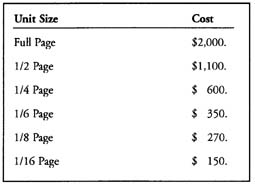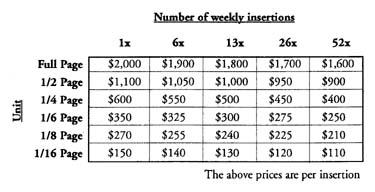
| next page in lesson--> | |
| Lesson
Four: The Rate Card Part 5: Modular Rates |
|
The
Rate Card: Modular rates
Although rate cards
are pretty simple after you learn how to read them, there is one more
way rates are offered that's even easier. Some call them modular rates,
and they're easier because there's no calculating involved. With all the
previous rate structures we've discussed, once you find the proper rate,
you still have to multiply it by the ad's total column-inches to get the
final cost of the ad.
But some newspapers make it much simpler by limiting the ad sizes the advertiser is allowed to run and then displaying each ad size and the total cost of each ad. Some newspapers call the various ad sizes "modular units" and are usually in sizes that fit together well. Because of this, you might find special sections having a rate structure like this to make production of the section that much easier. Check out our sample modular rate card in it's simplest form. Common modular sizes are full page, half page vertical, half page horizontal, quarter page, eighth page, and sixteenth of a page.

Sample modular
discount rate structure
Now take a look at the next rate structure. As you can see, this table combines modular sizes with a frequency discount. The more modular ads the account agrees to run, the cheaper the rate. In our example for instance, the advertiser running a full page once will be charged $2,000, while the advertiser running that same page 52 times, will be charged only $1,600 per insertion.

Sample modular discount rate structure combined with frequency
By the way, some big ad agencies might not be willing to change ads they're already running elsewhere to fit in it to your modular sizes, although many times agencies are willing to "float" the ad in the next larger size, or have you reduce it to fit the next smaller size. Take a look at your newspapers rate card and see how your rates fit in. Remember, there might be not only different rates but a different rate structure for every product you're selling, including ROP, classified display, preprinted inserts, special sections, your Internet site if you have one, and even special dining or entertainment guides.
Also, if you're working for a daily newspaper, again, many of these newspapers have frequency contracts within the week. So if you run an ad multiple times within the week the advertiser gets a discount. This isn't a bad idea for an advertiser who wants to make sure everyone sees his ad during the course of a week, since some people might miss the ad one day or not even read the issue that day. Your manager should have statistics on how much of the newspaper's readers you're reaching with one ad insertion, how many you're reaching if it runs twice within the week, and so on. For some newspapers, this is one of the biggest selling tools they use to encourage advertisers to run more frequently.
![]()